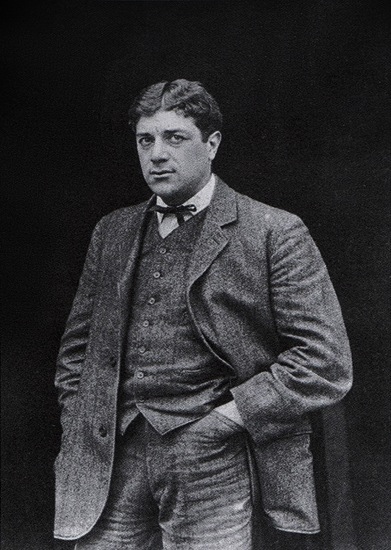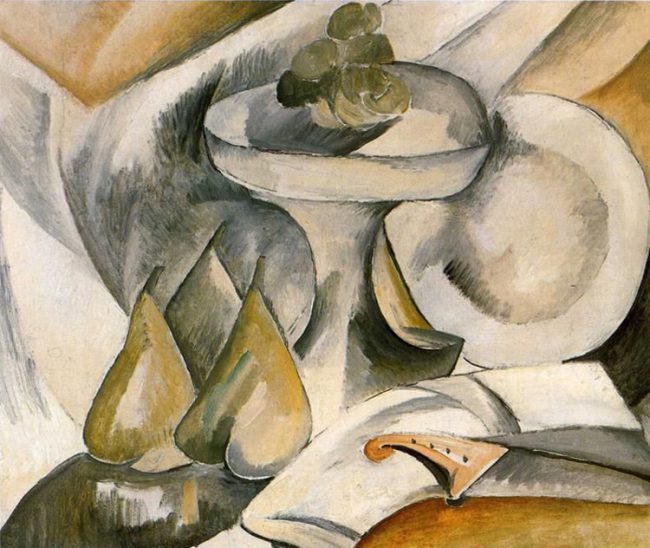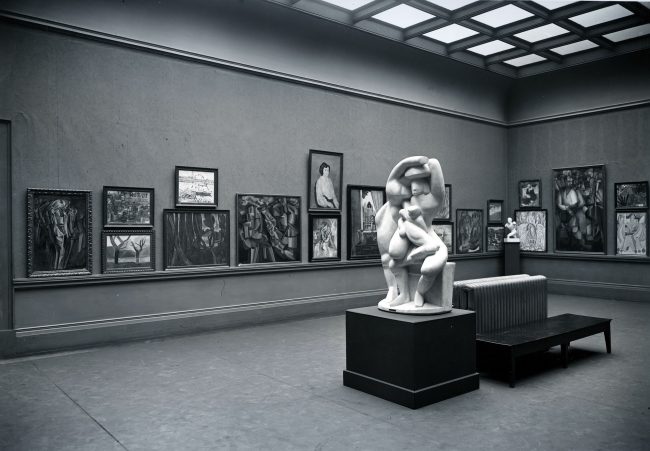
Georges Braque (1882-1963), photograph published in Gelett Burgess, The Wild Men of Paris, Architectural Record, May 1910
On May 13, 1882, French painter and sculptor Georges Braque was born, who, along with Pablo Picasso, developed the art style known as Cubism, an early-20th-century avant-garde art movement that revolutionized European painting and sculpture. In Cubist artwork, objects are analyzed, broken up and reassembled in an abstracted form—instead of depicting objects from one viewpoint, the artist depicts the subject from a multitude of viewpoints to represent the subject in a greater context.
“In art progress consists not in extension but in the knowledge of its limits.”
— George Braque, quote from the review ‘Nord-Sud’, December 1917
The Invention of a New Style
Did you known that Cubism, which flourished in the 1910s-20s, has been considered the most influential art movement of the 20th century? Actually, Cubism began somewhere between 1907 and 1911. Pablo Picasso’s famous 1907 painting Les Demoiselles d’Avignon has often been considered a proto-Cubist work.[6] But almost at the same time, Georges Braque’s 1908 Houses at L’Estaque prompted the critic Louis Vauxcelles to refer to bizarreries cubiques (cubic oddities). But, no matter who really “invented” the new style, George Braque is considered as one of its influential artists. George Braque was born on May 13, 1882 in Argenteuil, Val-d’Oise, France. He grew up in Le Havre and was trained to be a house painter and decorator like his father and also his grandfather. Nevertheless, he also studied artistic painting during evenings at the École des Beaux-Arts, in Le Havre. In 1903, he attended the Académie Humbert in Paris. Braque’s earliest paintings were impressionistic, but after seeing the work exhibited by the artistic group known as the “Fauves” (Beasts) in 1905, a group that included among others famous Henri Matisse and used brilliant colors to represent emotional response, Braque adopted the Fauvist style.[5]
Braque’s Evolution
Braque’s style began a slow evolution as he became influenced by Paul Cézanne, who had died in 1906, and a 1907 Cézanne retrospective at the Salon d’Automne greatly affected the avant-garde artists of Paris, resulting in the advent of Cubism. Braque’s paintings of 1908–1913 reflected his new interest in geometry and simultaneous perspective. In 1909, Braque began to work closely with Pablo Picasso, who had been developing a similar style of painting. But, in difference to Picasso, Braque was interested mainly in developing Cézanne’s ideas of multiple perspectives. Picasso celebrates animation, while Braque celebrates contemplation.
“The painter thinks in terms of form and color. The goal is not to be concerned with the reconstitution of an anecdotal fact, but with constitution of a pictorial fact.”
— Artists on Art…(1972), p. 423 – Braque’s quote, Paris 1917
Picasso and Braque
Actually, the term ‘Cubism‘, first pronounced in 1911 with reference to artists exhibiting at the Salon des Indépendants, quickly gained wide use but Picasso and Braque did not adopt it initially. Braque and Picasso spent a few weeks in the summer of 1911 in the small town of Céret in southern France. Here they continued their intensive exchange that they had begun in Paris, and the period of the most productive collaboration between the two artists began.

Georges Braque, 1908, Plate and Fruit Dish, oil on canvas, 46 x 55 cm, private collection
While Braque painted the man with guitar, Picasso answered with the congenial accordionist. In the still lifes Candlestick (Braque) and Still Life with Fan (Picasso), both artists incorporated the title of the daily newspaper L’Indépendant, written in Gothic font, into their motifs. Picasso returned to Paris in early September, Braque remained in Céret until January 1912, but corresponded frequently with Picasso. The first paper sculptures of Braque are also dated in this period, which earned him the nickname Wilbur Wright (after the designer of biplane planes) from Picasso. Braque’s and Picasso’s productive collaboration continued and they worked closely together until World War I in 1914, when Braque enlisted with the French Army.

Armory Show, International Exhibition of Modern Art. The Cubist room, Gallery 53 (northeast view), Art Institute of Chicago, March 24–April 16, 1913
From Cubism to Surrealism
In 1915 Braque was seriously wounded in the head during a frontal operation. After a long convalescence in Sorgues, he returned to Paris in spring 1917 and frequently met Juan Gris and the sculptor Henri Laurens. He no longer had any personal contact with Picasso. He distanced himself from Cubism and developed his own style, in which he mainly painted still lifes. In 1930 he built a country house in the seaside resort of Varengeville-sur-Mer (near Dieppe). In 1933 the Kunsthalle Basel in Switzerland organized the first review of the artist’s work up to that time. In the 1930s and 1940s Braque painted motifs in which figure and space (Painting Woman, 1936) and space and interior (Pool Table, 1945) interpenetrate each other. In his studio paintings, created in 1946, Braque used a large white bird, originally the motif of a painting that Braque had destroyed. From 1947 he worked with the lithographer Fernand Mourlot in Paris, who has been printing his lithographs ever since.In difference to Picasso, who always reinvented his style of painting and was heavily influenced by surrealism, Braque maintained the cubist method of simultaneous perspective and fragmentation. By the time of his death on August 31, 1963, he was regarded as one of the elder statesmen of modern art.
Claire Barry, Picasso and Braque’s Cubist Experiment: “Like mountain climbers roped together”?, [9]
References and Further Reading:
- [1] Georges Braque Website
- [2] Georges Braque at the Museum of Modern Art
- [3] The course of a painter in the representation of the landscape: Georges Braque
- [4] Paul Cézanne – Breaking all the Rules, SciHi Blog, January 19, 2018
- [5] Henri Matisse in the Rush of Colors, SciHi Blog, December 31, 2012
- [6] Pablo Picasso – A Giant in Arts, SciHi Blog, October 25, 2012
- [7] Auguste Rodin – Progenitor of Modern Sculpture, SciHi Blog, November 12, 2012
- [8] Georges Braque at Wikidata
- [9] Claire Barry, Picasso and Braque’s Cubist Experiment: “Like mountain climbers roped together”?, Santa Barbara Museum of Art @ youtube
- [10] Orozco, Miguel (2018) “The Complete Prints of Georges Braque. Catalogue raisonné“. Academia.edu
- [11] Georges Braque, L’Esprit nouveau: revue internationale d’esthétique, 1920. Gallica, Bibliothèque nationale de France
- [12] Georges Braque Timeline via Wikidata





